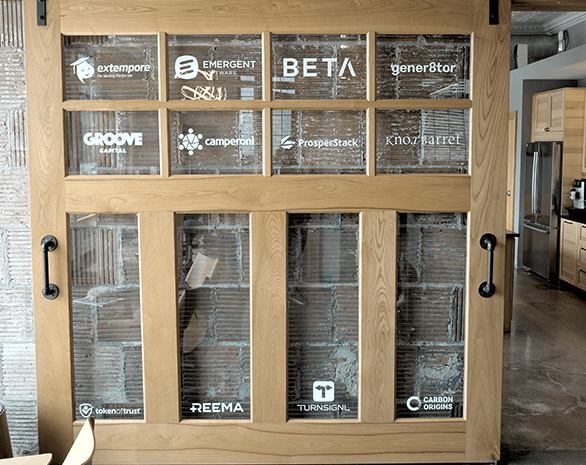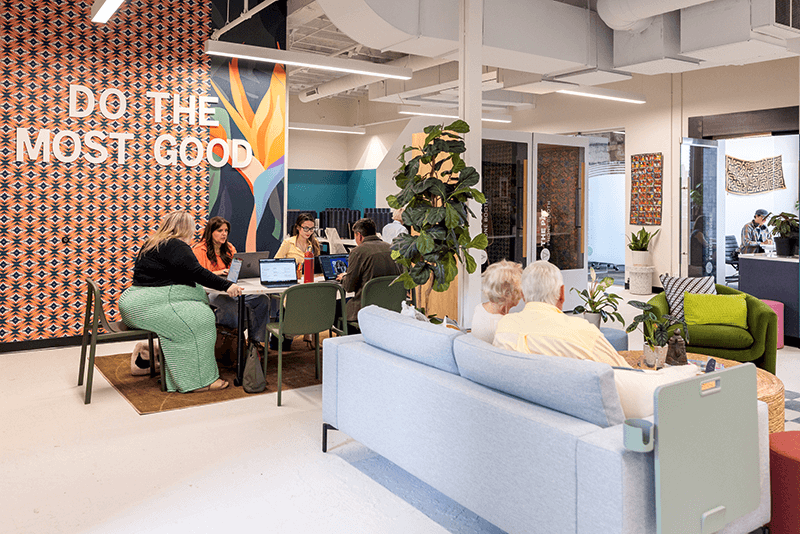On June 18, The Coven, 2125 E Hennepin Ave., opened. It is a new coworking space — a trend that is starting to change work environments for remote workers, entrepreneurs and startups.
“It’s really open to everybody and it’s been fascinating to see the types of people,” Lisa Mangelsdorf, the community owner of The Coven NE, said. “We have poets and construction companies.”
The Coven is the fifth location in Northeast Minneapolis to focus on a collaborative work environment, joining Coco Coworking, The Office Minneapolis, Twin Ignition and Northeast Collaborative.
CoworkingCafe, a listing site for these types of spaces, ranked Minneapolis and St. Paul as the 19th best market for coworking, with the cities having 98 spaces in total in 2024.
Collaborative work models are growing and showing staying power, but what exactly do they mean and what do they do?

A door in Twin Ignition displays some current and former members that found success in the collaborative workspace. (Davis Steen)
What is a coworking space?
3M, Target and United Healthcare are headquartered in Minnesota, and most are familiar with how they work. They are large organizations servicing millions of people, and they need many employees to fill those needs. They tend to have large campuses with many offices and cubicles.
When a company has five or fewer people, or when it’s just a single person, its needs change. It no longer needs a large campus, but they still may desire to be part of a larger collective.
Enter the collaborative working model and coworking spaces.
“As a startup, you don’t spend money on your brick-and-mortar location,” Seth Peter said. “They want the commonality and the community.”
Peter is a founding partner of Twin Ignition Startup Garage, 1317 Marshall St. NE. The collaborative office space has been around since 2020, servicing entrepreneurs and startups for the past 5 years.
What is a startup?
Startup companies are small businesses, usually in their first few years of operation, that have a new product or way of doing things. Historically, they have been associated with San Francisco and the Silicon Valley.
Twin Ignition’s goal is to foster the startup community in Northeast Minneapolis, though with some notable differences.
“We’re solving problems here in the Midwest,” Peter said.
The office space of Twin Ignition holds many different companies. Like an office building, private desks with doors line the wall. Where it differs is in the shared spaces, like a table in the middle where any member of the Garage can set up.
The companies and individuals pay a fee to be members, whether through a monthly membership or other contracts. It’s ultimately cheaper to pay this fee than to rent a space.
What does a startup do?
“We’ve got everything from robots to little tools that predict your ear infection early on,” Meghann Busch said. “We had a cooking app. All kinds of stuff.”
Busch is the operations manager at Twin Ignition, and she has become an asset for the companies that pay to be in the space.
“I’m an extension of every startup that is in here,” Busch said. “They don’t have to do everything alone; we can help.”
While Twin Ignition is focused on the business side, it hopes the arts community, and the creativity in it, will go hand-in-hand with the startup community.
“We aren’t mirroring the Arts District, but we are participating in it,” Busch said. “We can learn a lot from the artists.”
The space does mirror, however, a studio you would see in Northrup King or Casket Arts Buildings. A woodworking studio sits in the back and art lines almost every wall.
“You’re welcome to come see the Joe Gallup art,” Busch said. The office features a few pieces by Gallup and some woodworking designs by Peter as well.
Can startups work in Minneapolis?
Startups have been referred to as “the engine of economic growth” by various business publications. A recent paper from the Journal of Political Economy found that 5% of people in the United States work for startups but these companies are responsible for 15% of job creation.
The reason Minneapolis is a good place to foster startups has to do with the existing businesses that have started and grown in the area.
“The Twin Cities is sometimes known as a headquarter economy,” Peter said. “We do see a lot of companies where people work with an organization and they have an idea, so they are pursuing that idea on their own.”
Growing the roots
The Urban Institute in 2018 found that, on average, less than 1% of companies move out of the area where they started. That number is smaller for companies that start within metropolitan areas. Companies tend to stay where they start.
Peter aligned with this sentiment, adding, “This is a place for business to get started. What we hope is that then these businesses will stay in the community. Establishing those early roots.”
On top of that, starting a company comes with many costs that don’t necessarily pertain to the business. “We’re trying to cut down on some of those barriers to entry for these early companies,” Peter said.
All of this is with the goal of strengthening the Northeast economy. But what if you aren’t a startup but need that community?

The setup of The Coven allow members to easily collaborate with others in the space. (Bethany Birnie)
Enter The Coven
A pop of color, a vibrant space and an open floor plan are the first things one would notice walking into The Coven’s space on East Hennepin Avenue.
“The Coven has set up colorful bright spaces,” Mangelsdorf said. “This isn’t just a desk.”
“People have left their places and traditional community gatherings,” Alex West Steinman said. “The rise of coworking with a change on a traditional model that was just an office space. They’ve been relying more on their places to be their community.”
Alex West Steinman is a co-founder and the CEO of The Coven. The Northeast location marks the seventh site of the business, which started in Minneapolis and St. Paul.
“Coworking was originally created as a place for someone to work,” Steinman said. But as the pandemic gets further in the rearview mirror, people need it for more than just a desk.
“A majority of our membership have their own home office, but they use this space too,” Steinman said. “The blending of work and space can work in a place like this. It’s a blending space.”
Getting stuff done
Harvard Business Review took a hard look at coworking spaces back in 2015. A study they referenced showed that people belonging to a coworking space reported they were thriving more often than someone in a traditional office space.
“People use these spaces for connecting with folks across different industries,” Steinman said. “Really, to get stuff done.”
In a typical work setting, people are within the same company. While they are working towards the same goals, they don’t get the perspective of others who could help.
“(Of our members) 2% of every industry is in The Coven,” Steinman said. “50% are entrepreneurs. We have a healthy mix of solo workers and W2 employees within a larger company.”
Harvard Business Review said the lack of direct competition and internal politics found in a coworking space allows workers to focus on the work and get creativity from others that work in different industries.
“People find themselves the most productive in a place that fosters creativity,” Steinman said.
“The root of the word is ‘to convene’”
The word “coven” carries a negative connotation. The Merriam-Webster Dictionary has two definitions. The second one is “An assembly or band of usually 13 witches.”
The first — the more commonly used one —
is “A collection of individuals with similar interests.”
“It felt unique, and it felt really us,” Steinman said, though she didn’t shy away from the word’s roots in witchcraft, either. “That magic that happens when people are connected to one another. You’re going to remember the name; you’re going to remember how you feel.”
With a collective word at its center, The Coven hopes to join in on the convening happening in the area. “Northeast in general is a gathering space; the whole area is always gathering,” Mangelsdorf said.
Collaboration isn’t a new concept
The Foundation for Economic Education wrote in a 2024 article that economies will find themselves in what is called a “scarcity” model. This refers to limited resources and that one person’s gain is always to the detriment of others.
“We subscribe to our collaboration over competition and the abundance model,” Steinman said.
This abundance model, or the opposite of scarcity, is not necessarily a new concept for the area. The Arts District recently opened their gathering space and have been growing their community through this model for the past 30 years.
“Early-stage companies and artists come from the same place,” Peter said. “They all understand each other well.”